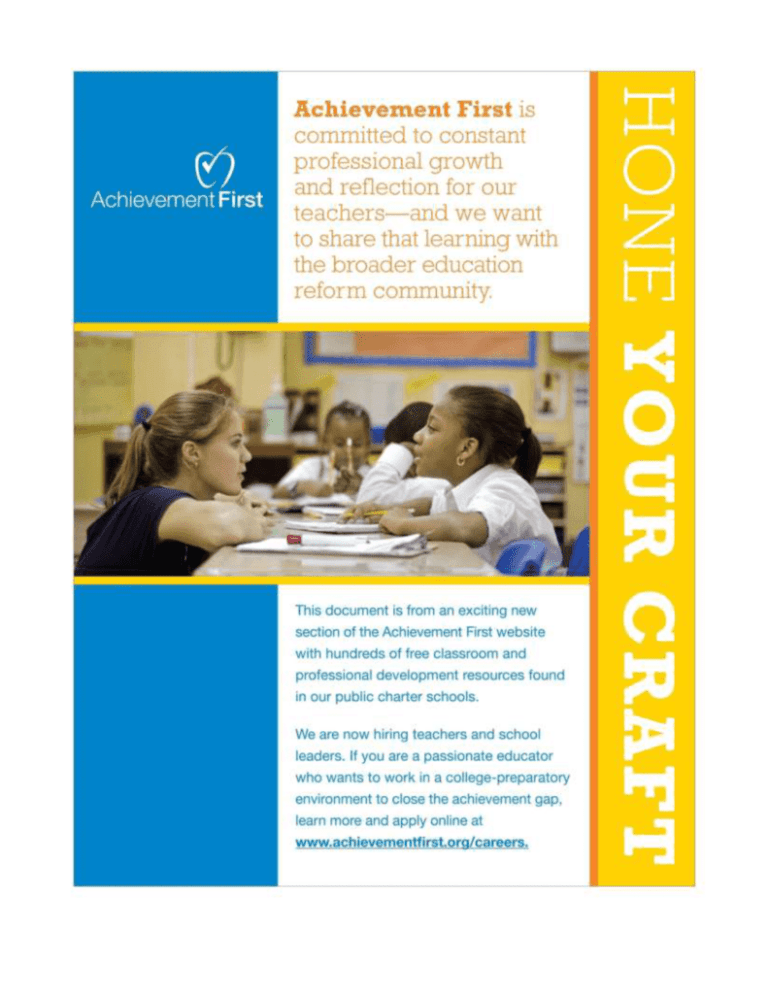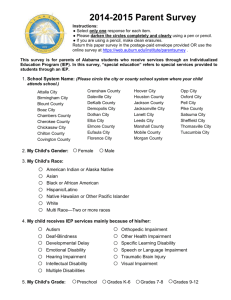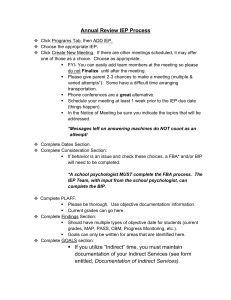IEP writing guide - Achievement First
advertisement

IEP TEMPLATE
INDIVIDUALIZED EDUCATION PROGRAM (IEP)
STUDENT NAME: PUT THE SCHOLARS NAME HERE
DATE OF BIRTH:
LOCAL ID #:
DISABILITY CLASSIFICATION:
PROJECTED DATE IEP IS TO BE IMPLEMENTED:
PROJECTED DATE OF ANNUAL REVIEW:
PRESENT LEVELS OF PERFORMANCE AND INDIVIDUAL NEEDS
INCLUDING SENTENCE STARTERS. REMEMBER THESE ARE STARTERS! YOU NEED TO ADD INFORMATION! THE INFORMATION YOU ADD MAY REQUIRE
THAT YOU CHANGE THE FORMAT OF ONE OF THE AREAS.
DOCUMENTATION OF STUDENT'S CURRENT PERFORMANCE AND ACADEMIC, DEVELOPMENTAL AND FUNCTIONAL NEEDS
EVALUATION RESULTS (INCLUDING FOR SCHOOL-AGE STUDENTS, PERFORMANCE ON STATE AND DISTRICT-WIDE ASSESSMENTS)
___________ is a ________________ year old ______________ grader.
State assessment results: 2011 NYS ELA: __________ 2011NYS Math: _________________
Hint:
1: below standard
2: not proficient
3: proficient
4: advanced
ACADEMIC ACHIEVEMENT, FUNCTIONAL PERFORMANCE AND LEARNING CHARACTERISTICS
LEVELS OF KNOWLEDGE AND DEVELOPMENT IN SUBJECT AND SKILL AREAS INCLUDING ACTIVITIES OF DAILY LIVING, LEVEL OF INTELLECTUAL FUNCTIONING,
ADAPTIVE BEHAVIOR, EXPECTED RATE OF PROGRESS IN ACQUIRING SKILLS AND INFORMATION, AND LEARNING STYLE:
_______________ is a {positive word/words} . We are individualizing his/her education because of his/her unique needs related to his disability in the areas of
listening, speaking, reading, writing, computation, problem solving, organization, memory, attention, and motor skills.
Update the below as needed; only include areas that are important to the scholar who you are writing about. If you list an area above, make sure
you describe it below. Remember to include POSITIVE statements. Remember to give specific data and details. Sometimes, it is good to give
an example also.
Listening
New York State Education Department IEP Form
In the skill of listening, ________________________ is able to _______________________, but is unable to _____________________________.
Speaking:
In the area of speaking In both class and social settings, _______________ ___________________able to __________________, but is unable
_________________________________________
Reading:
In the area of reading, ________________ is able to sound out words at a _____________ grade level. He was able to read a ___________grade text (level____)
with __________% accuracy. He was able to read a _________ grade (level _________) text at a rate of _________ wpm. He is also able to comprehend
_____________________ grade level texts at a literal and inferential level. He is unable to decode ___________________. He is unable ________________. He
is unable to comprehend texts on his grade level and to answer comprehensions on grade level texts.
He particularly struggles
_______________________________________________________________________. Make sure you give specific details.
Math Computation:
In the area of computation, _______________________ is able to solve ________________________. He is also able to solve ___________________ problems.
__________________ is unable to ________________________________. He is unable to _____________________. Make sure you give details!
Math Problem Solving:
In the area of problem solving, _____________________________is able to complete _______________________________ on a _________ grade level He is
unable to complete ________________________________________
Writing:
When given the _______________________ test, which required him to sentences from given words, he was able to ____________________________on a
_______________ grade level. He was unable to _____________________. Give examples and details!
Other areas to include:
Handwriting
Following verbal instructions
Time on task
Organization
spelling
Do NOT include:
CONTENT areas such as science, history, music, or art.
STUDENT STRENGTHS, PREFERENCES, INTERESTS:
________________________ demonstrates strength at _______________________________. S/he enjoys ___________________________________. S/he is
an excellent _______________________________________________.
New York State Education Department IEP Form
Think about including:
Type of work: group, partner, independent
Things that motivate the student
ACADEMIC, DEVELOPMENTAL AND FUNCTIONAL NEEDS OF THE STUDENT, INCLUDING CONSIDERATION OF STUDENT NEEDS THAT ARE OF CONCERN TO THE
PARENT:
_____________________ is ______________________________on/off task.
SOCIAL DEVELOPMENT
THE DEGREE (EXTENT) AND QUALITY OF THE STUDENT'S RELATIONSHIPS WITH PEERS AND ADULTS; FEELINGS ABOUT SELF; AND SOCIAL ADJUSTMENT TO SCHOOL
AND COMMUNITY ENVIRONMENTS:
__________________________ is a [positive word] student.
Think about including information that relates to the prompts above. The social worker or guidance counselor at your school will complete this section for
scholars who get counseling. Talk to your SpEd coordinator about what to do if the scholar does not get counseling.
STUDENT STRENGTHS:
SOCIAL DEVELOPMENT NEEDS OF THE STUDENT, INCLUDING CONSIDERATION OF STUDENT NEEDS THAT ARE OF CONCERN TO THE PARENT:
PHYSICAL DEVELOPMENT
THE DEGREE (EXTENT) AND QUALITY OF THE STUDENT’S MOTOR AND SENSORY DEVELOPMENT, HEALTH, VITALITY AND PHYSICAL SKILLS OR LIMITATIONS WHICH
PERTAIN TO THE LEARNING PROCESS:
Possible things to include:
Wears corrective lenses (glasses)
History of Asthma
STUDENT STRENGTHS:
PHYSICAL DEVELOPMENT NEEDS OF THE STUDENT, INCLUDING CONSIDERATION OF STUDENT NEEDS THAT ARE OF CONCERN TO THE PARENT:
MANAGEMENT NEEDS
THE NATURE (TYPE) AND DEGREE (EXTENT) TO WHICH ENVIRONMENTAL AND HUMAN OR MATERIAL RESOURCES ARE NEEDED TO ADDRESS NEEDS IDENTIFIED
ABOVE:
Needs to consider:
How content is delivered (graphic organizers, advanced warning, large text, with pictures)
New York State Education Department IEP Form
How content is interacted with (read aloud, highlighted, underlined…)
How instructions/directions are delivered (repetition, with visual support…)
Possible things to include:
Requires frequent prompting to _______________ at intervals of no more than ________________minutes
Positive praise
Advanced warning before…(transition, questioning, etc)
Seating at (the front/back/side of room)
EFFECT OF STUDENT NEEDS ON INVOLVEMENT AND PROGRESS IN THE GENERAL EDUCATION CURRICULUM OR, FOR A PRESCHOOL STUDENT, EFFECT
OF STUDENT NEEDS ON PARTICIPATION IN APPROPRIATE ACTIVITIES
STUDENT NEEDS RELATING TO SPECIAL FACTORS
BASED ON THE IDENTIFICATION OF THE STUDENT'S NEEDS, THE COMMITTEE MUST CONSIDER WHETHER THE STUDENT NEEDS A PARTICULAR DEVICE OR SERVICE
TO ADDRESS THE SPECIAL FACTORS AS INDICATED BELOW, AND IF SO, THE APPROPRIATE SECTION OF THE IEP MUST IDENTIFY THE PARTICULAR DEVICE OR
SERVICE(S) NEEDED.
Does the student need strategies, including positive behavioral interventions, supports and other strategies to address behaviors that impede the student's learning or
that of others?
Yes
No
Does the student need a behavioral intervention plan?
No
Yes:
For a student with limited English proficiency, does he/she need a special education service to address his/her language needs as they relate to the IEP?
Yes
No
Not Applicable
For a student who is blind or visually impaired, does he/she need instruction in Braille and the use of Braille?
Yes
No
Not Applicable
Does the student need a particular device or service to address his/her communication needs?
Yes
No
In the case of a student who is deaf or hard of hearing, does the student need a particular device or service in consideration of the student's language and
communication needs, opportunities for direct communications with peers and professional personnel in the student's language and communication mode,
academic level, and full range of needs, including opportunities for direct instruction in the student's language and communication mode?
Yes
No
Not Applicable
Does the student need an assistive technology device and/or service?
Yes
No
If yes, does the Committee recommend that the device(s) be used in the student's home?
Yes
No
BEGINNING NOT LATER THAN THE FIRST IEP TO BE IN EFFECT WHEN THE STUDENT IS AGE 15 (AND AT A YOUNGER AGE IF DETERMINED APPROPRIATE)
MEASURABLE POSTSECONDARY GOALS
LONG-TERM GOALS FOR LIVING, WORKING AND LEARNING AS AN ADULT
EDUCATION/TRAINING:
EMPLOYMENT:
New York State Education Department IEP Form
INDEPENDENT LIVING SKILLS (WHEN APPROPRIATE):
TRANSITION NEEDS
In consideration of present levels of performance, transition service needs of the student that focus on the student's courses of study, taking into account the student’s
strengths, preferences and interests as they relate to transition from school to post-school activities:
MEASURABLE ANNUAL GOALS
THE FOLLOWING GOALS ARE RECOMMENDED TO ENABLE THE STUDENT TO BE INVOLVED IN AND PROGRESS IN THE GENERAL EDUCATION CURRICULUM, ADDRESS
OTHER EDUCATIONAL NEEDS THAT RESULT FROM THE STUDENT'S DISABILITY, AND PREPARE THE STUDENT TO MEET HIS/HER POSTSECONDARY GOALS.
ANNUAL GOALS
CRITERIA
METHOD
SCHEDULE
WHAT THE STUDENT WILL BE EXPECTED TO ACHIEVE BY THE
MEASURE TO DETERMINE IF
HOW PROGRESS WILL BE
WHEN PROGRESS WILL
END OF THE YEAR IN WHICH THE IEP IS IN EFFECT
GOAL HAS BEEN ACHIEVED
MEASURED
BE MEASURED
Within one year, __________________ will improve
Choose one or more:
1 time per trimester
his/her _________________ in the area of
_____ % accuracy
performance assessment
______________________________ by
standardized test
_____________________________________________
teacher-created materials
______________________________________
REPORTING PROGRESS TO PARENTS
Identify when periodic reports on the student's progress toward meeting the annual goals will be provided to the student's parents: 3 times per year at the end of
each trimester of school
New York State Education Department IEP Form
)
REPORTING PROGRESS TO PARENTS
Identify when periodic reports on the student's progress toward meeting the annual goals will be provided to the student's parents:
RECOMMENDED SPECIAL EDUCATION PROGRAMS AND SERVICES
SPECIAL EDUCATION PROGRAM/SERVICES
SPECIAL EDUCATION PROGRAM:
SERVICE DELIVERY
RECOMMENDATIONS*
FREQUENCY
DURATION
LENGTH OF
WHERE SERVICE WILL BE
PROVIDED
SESSION
PROVIDED
HOW OFTEN
LOCATION
PROJECTED
BEGINNING/
SERVICE
DATE(S)
RELATED SERVICES:
SUPPLEMENTARY AIDS AND SERVICES/PROGRAM
MODIFICATIONS/ACCOMMODATIONS:
ASSISTIVE TECHNOLOGY DEVICES AND/OR
SERVICES:
SUPPORTS FOR SCHOOL PERSONNEL ON BEHALF
OF THE STUDENT:
*
Identify, if applicable, class size (maximum student-to-staff ratio), language if other than English, group or individual services, direct and/or indirect consultant
teacher services or other service delivery recommendations.
New York State Education Department IEP Form
12-MONTH SERVICE AND/OR PROGRAM – Student is eligible to receive special education services and/or program during July/August:
If yes:
Student will receive the same special education program/services as recommended above.
OR
Student will receive the following special education program/services:
SPECIAL EDUCATION PROGRAM/SERVICES
SERVICE DELIVERY
RECOMMENDATIONS
FREQUENCY
DURATION
LOCATION
No
Yes
PROJECTED
BEGINNING/
SERVICE DATE(S)
Name of school/agency provider of services during July and August:
For a preschool student, reason(s) the child requires services during July and August:
TESTING ACCOMMODATIONS (TO BE COMPLETED FOR PRESCHOOL CHILDREN ONLY IF THERE IS AN ASSESSMENT PROGRAM FOR NONDISABLED PRESCHOOL CHILDREN):
INDIVIDUAL TESTING ACCOMMODATIONS, SPECIFIC TO THE STUDENT’S DISABILITY AND NEEDS, TO BE USED CONSISTENTLY BY THE STUDENT IN THE
RECOMMENDED EDUCATIONAL PROGRAM AND IN THE ADMINISTRATION OF DISTRICT-WIDE ASSESSMENTS OF STUDENT ACHIEVEMENT AND, IN ACCORDANCE
WITH DEPARTMENT POLICY, STATE ASSESSMENTS OF STUDENT ACHIEVEMENT
TESTING ACCOMMODATION
CONDITIONS*
IMPLEMENTATION RECOMMENDATIONS**
NONE
Extended time
Extended time
*Conditions – Test Characteristics: Describe the type, length, purpose of the test upon which the use of testing accommodations is conditioned, if applicable.
New York State Education Department IEP Form
**Implementation Recommendations: Identify the amount of extended time, type of setting, etc., specific to the testing accommodations, if applicable.
BEGINNING NOT LATER THAN THE FIRST IEP TO BE IN EFFECT WHEN THE STUDENT IS AGE 15 (AND AT A YOUNGER AGE, IF DETERMINED APPROPRIATE).
COORDINATED SET OF TRANSITION ACTIVITIES
NEEDED ACTIVITIES TO FACILITATE THE
STUDENT’S MOVEMENT FROM SCHOOL TO
POST-SCHOOL ACTIVITIES
SERVICE/ACTIVITY
SCHOOL DISTRICT/
AGENCY RESPONSIBLE
Instruction
Related Services
Community Experiences
Development of Employment and Other Postschool Adult Living Objectives
Acquisition of Daily Living Skills (if applicable)
Functional Vocational Assessment (if applicable)
PARTICIPATION IN STATE AND DISTRICT-WIDE ASSESSMENTS
(TO BE COMPLETED FOR PRESCHOOL STUDENTS ONLY IF THERE IS AN ASSESSMENT PROGRAM FOR NONDISABLED PRESCHOOL STUDENTS)
The student will participate in the same State and district-wide assessments of student achievement that are administered to general education students.
The student will participate in an alternate assessment on a particular State or district-wide assessment of student achievement.
Identify the alternate assessment:
Statement of why the student cannot participate in the regular assessment and why the particular alternate assessment selected is appropriate for the student:
PARTICIPATION WITH STUDENTS WITHOUT DISABILITIES
REMOVAL FROM THE GENERAL EDUCATION ENVIRONMENT OCCURS ONLY WHEN THE NATURE OR SEVERITY OF THE DISABILITY IS SUCH THAT, EVEN WITH THE USE
OF SUPPLEMENTARY AIDS AND SERVICES, EDUCATION CANNOT BE SATISFACTORILY ACHIEVED.
FOR THE PRESCHOOL STUDENT:
Explain the extent, if any, to which the student will not participate in appropriate activities with age-appropriate nondisabled peers (e.g., percent of the school day
and/or specify particular activities):
FOR THE SCHOOL-AGE STUDENT:
Explain the extent, if any, to which the student will not participate in regular class, extracurricular and other nonacademic activities (e.g., percent of the school day
New York State Education Department IEP Form
and/or specify particular activities):
If the student is not participating in a regular physical education program, identify the extent to which the student will participate in specially-designed instruction in
physical education, including adapted physical education:
EXEMPTION FROM LANGUAGE OTHER THAN ENGLISH DIPLOMA REQUIREMENT:
No
Yes - The Committee has determined that the student's disability
adversely affects his/her ability to learn a language and recommends the student be exempt from the language other than English requirement.
SPECIAL TRANSPORTATION
TRANSPORTATION RECOMMENDATION TO ADDRESS NEEDS OF THE STUDENT RELATING TO HIS/HER DISABILITY
None.
Student needs special transportation accommodations/services as follows:
Student needs transportation to and from special classes or programs at another site:
PLACEMENT RECOMMENDATION
New York State Education Department IEP Form





